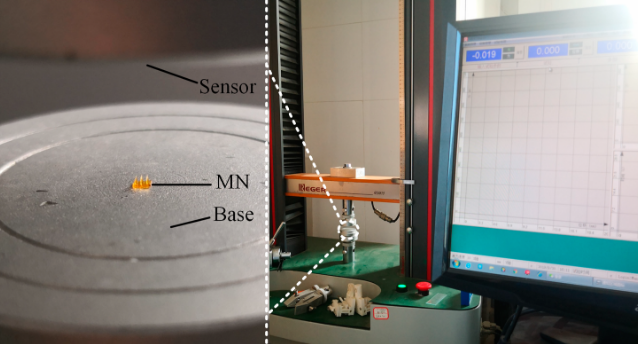Chinese researchers are finding better ways to create microneedles, helping patients avoid some of the pain and discomfort offered by more conventional injection devices. Novel, 3D printed hydrogel microneedles help complete a variety of critical tasks, to include drug delivery, outlined in the recently published ‘3D Printed Multi-Functional Hydrogel Microneedles Based on High-Precision Digital Light Processing.’
The use of microneedles continues to increase due to benefits they offer patients, along with uses such as vaccinations, sensors (for instance, to test for potassium levels), and measurements for everything from glucose levels to that of alcohol. Scientists and medical researchers employ a wide variety of microneedles (usually made from polymers), such as solid, coated, dissolving, and hydrogel-forming:
“Solid MNs are utilized in non-coated quadratic process, by which the micropore is firstly generated on skin and then the drug is delivered through the micropore. Thus, this method is relatively rough and could cause irreversible wound. Coated MNs, which coats the surface of polymer microneedles with drug and penetrates directly through the cuticle of the skin. However, its dosage is difficult to control and quantify. Dissolving MNs use biocompatible polymers to encapsulate drugs such as viral inactivated vaccines, which could penetrate skin and dissolve automatically within minutes,” explain the researchers.
“Recently, Hydrogel-Forming Microneedles are developed because of high-biocompatibility and natural porous structure.”
Microneedles can be controlled with water, used to expand and create in-situ conduits. And while microneedles are excellent vehicles for injection, they can also serve other purposes such as allowing fluorescent substances to be combined with materials for sensing antigens.
In this study, the scientists were mainly concerned with creating high-performance yet affordable hydrogel microneedles through high-precision digital light processing (H-P DLP). This method is also beneficial as hydrogel MNs can also be fabricated in different shapes. Samples were printed with varying exposure times, and then the authors collected data regarding the resulting mechanical properties.
Ultimately, the exposure time was the controlling method for precision and stiffness, showing a decline when set over 300ms, but with stiffness increasing simultaneously. Upon completing the study, the authors noted 300ms as the ‘ideal exposure time’ for building MNs.
“Photosensitive resin used in SLA has poor biocompatibility. Combining template driven fabrication with UV curing materials is a complicated process,” concluded the researchers. “Comparing with those microneedles, hydrogel microneedles could be used for drug loading and the drug loading capacity is greatly increased. The fabrication time of biocompatible microneedles is greatly reduced owe to the ordinal fabrication of base and needles. The fabrication of several microneedles could be completed only in few minutes.
“ … the results of drug injection and drug detection were analyzed quantitatively, which may provide a certain reference for micro needle using in biological injection and drug extraction. Due to the low-cost, painless, short manufacturing time, well biocompatibility, and drug delivery performance properties of 3D built MNs, it is exciting to adapt MNs to the market. We expect to apply 3D printed MNs with properties above to clinical usage in the future.”
3D printing continues to be a catalyst for change in the realm of medical devices, and increasingly so for smaller components like microneedles, whether they are being used for transdermal drug delivery, innovative treatments for examples such as diseases of the eye, and other biomedical applications.
What do you think of this news? Let us know your thoughts! Join the discussion of this and other 3D printing topics at 3DPrintBoard.com.

The picture of side face of MNs with different exposure time: (a) 50 ms; (b) 100 ms; (c) 300 ms; (d) 500 ms; (e) 700 ms; and (f) 900 ms. The scale bar is 200 µm.
Subscribe to Our Email Newsletter
Stay up-to-date on all the latest news from the 3D printing industry and receive information and offers from third party vendors.
You May Also Like
Industrial Giant Ingersoll Rand Leads $19M Round Backing Inkbit’s AI-Driven 3D Printing
Inkbit, the Massachusetts-based original equipment manufacturer (OEM) of multi-material, AI-integrated 3D printers, has closed a $19 million financing round. Ingersoll Rand, a US giant in the industrial equipment sector, led...
3D Printing Unpeeled: Digital FDM Filament for Functional Gradients
Just published in Nature, a paper by a Seoul National University team looks at “3D printing with a 3D printed digital material filament for programming functional gradients.” Sang-Joon Ahn, Howon...
3D Printing Unpeeled: $5000 Cold Spray 3D Printer, Roland DGA & Living Materials
The AeroForge is a $5000 cold spray metal printer for copper made by a student team at Rice University. In a paper for ACS Central Science a team from Nanjing...
3D Printing News Briefs, April 27, 2024: Research, Digital Dentistry, Cycling, & More
We’re starting today’s 3D Printing News Briefs with some research into 3D printed luminescent quantum-dot polymer architectures and free-form laser beam shaping, and then on to an open source 4-axis...

































